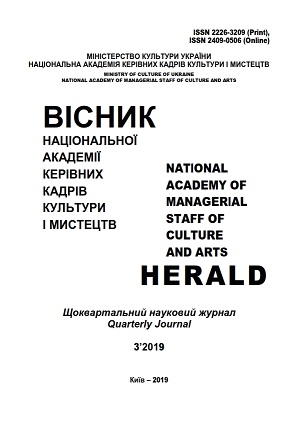«Марш» з опери «Любов до трьох апельсинів» Сергія Прокоф‘єва: перекладення для баяна
«March» from the Opera «Love to Three Oranges» by Sergij Prokofiev: Adaptation for Bayan
Author(s): Galyna Vasylivna OleksivSubject(s): Theatre, Dance, Performing Arts, Music
Published by: Національна академія керівних кадрів культури і мистецтв
Keywords: adaptation for bayan; orchestral pieces; symphonic pieces; texture; timbre registers; adaptation;
Summary/Abstract: The purpose of the article is to highlight the peculiarities of the adaptation of the work from the repertoire of the symphony orchestra - "Marshing" from the opera "Love to Three Oranges" by S. Prokofiev for bayan. Since the translation of symphonic works for bayan has not yet become the subject of musicological research, the scientific novelty of the article is to highlight the basic principles of this kind of genre on the example of the proposed piece. Scientific novelty. Adaptation of orchestral works occupies a considerable part in the educational and concert repertoire for bayan. The specificity of this type of adaptation depends primarily on the composition of the orchestra for which the original was created. In addition to a number of stylistic features, the translation reproduces a multilevel orchestral texture, polytimbre and a palette of techniques for sound formation on various instruments. Adaptation of orchestral works for accordion, to a certain extent, play an important function of "accessible" and "compact" promotion of symphonic pieces. Methodology. The following methods were used in the study of the topic: analytical, stylistic, comparative, theoretical. The conclusions of the study summarize the main parameters of the translation of "Marching" from the opera "Love to Three Oranges" by S. Prokofiev in the timbreexpressive conditions of bayan. The presence of a palette of timbre registers of bayan, range, dynamic potential, a wealth of specific techniques of sound and blasting determine the ability of the instrument to reproduce the orchestral polytimbre. The expressive arsenal of the bayan allows displaying certain instruments as fully as possible, following their individual charateristics: timbre, tessitura, method of sound formation, specific audio-expressive techniques, etc. The contrasts of the bayan registers (clarinet, bassoon, picolo, tuti, etc.) successfully enhance the timbre juxtaposition of orchestral groups and reproduce the sound of many orchestral instruments. One of the varieties of creative interpretation of the bayan is "orchestra in miniature". Comprehensive analysis of the musical piece and methodological recommendations are the basis for a deeper understanding of the specific adaptation of the symphonic composition for bayan, rethinking textured, positional, applicative and timbre-register transformations, and therefore the quality of the musical piece.
Journal: Вісник Національної академії керівних кадрів культури і мистецтв
- Issue Year: 2019
- Issue No: 3
- Page Range: 291-295
- Page Count: 5
- Language: Ukrainian

